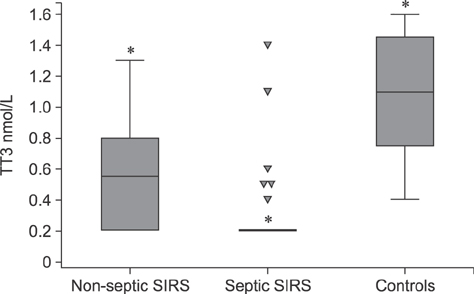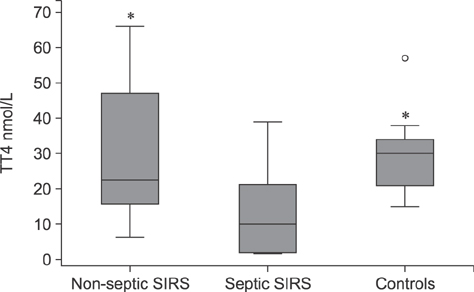J Vet Sci.
2017 Dec;18(4):471-477. 10.4142/jvs.2017.18.4.471.
Retrospective evaluation of circulating thyroid hormones in critically ill dogs with systemic inflammatory response syndrome
- Affiliations
-
- 1Department of Veterinary Medical Sciences, Alma Mater Studiorum-University of Bologna, 40126 Bologna, Italy. massimo.giunti@unibo.it
- KMID: 2398506
- DOI: http://doi.org/10.4142/jvs.2017.18.4.471
Abstract
- Critical illness can be associated with transient alterations in circulating thyroid hormone concentrations, indicating the presence of non-thyroidal illness (NTI). NTI is well described in humans, but there are few reports on its occurrence and prognostic significance in dogs. This retrospective study assessed the occurrence of NTI in a population of dogs with systemic inflammatory response syndrome (SIRS) and investigated its association with disease severity (APPLE(fast) scores). A total of 41 SIRS dogs were included and were divided by SIRS origin (non-septic SIRS, n = 10; septic SIRS, n = 41) and final outcome (survivors, n = 37; non-survivors, n = 4). Healthy, age-matched dogs (n = 15) were included as controls. Serum thyroid hormone levels including total T3, free T3, total T4, and reverse T3 were measured upon admission. Compared to controls, there were significant changes in serum thyroid hormone concentrations in SIRS dogs, suggesting the presence of NTI. Septic SIRS dogs had higher APPLE(fast) scores and lower serum thyroid hormones concentrations than those in non-septic SIRS and control dogs. In conclusion, NTI was frequent in dogs with SIRS and may be associated with the presence of sepsis or high illness severity.
MeSH Terms
Figure
Reference
-
1. Angelousi AG, Karageorgopoulos DE, Kapaskelis AM, Falagas ME. Association between thyroid function tests at baseline and the outcome of patients with sepsis or septic shock: a systematic review. Eur J Endocrinol. 2011; 164:147–155.
Article2. Battilani M, Balboni A, Ustulin M, Giunti M, Scagliarini A, Prosperi S. Genetic complexity and multiple infections with more Parvovirus species in naturally infected cats. Vet Res. 2011; 42:43.
Article3. Bentley AM, Mayhew PD, Culp WTN, Otto CM. Alterations in the hemostatic profiles of dogs with naturally occurring septic peritonitis. J Vet Emerg Crit Care (San Antonio). 2013; 23:14–22.
Article4. Boonen E, Van den Berghe G. Endocrine responses to critical illness: novel insights and therapeutic implications. J Clin Endocrinol Metab. 2014; 99:1569–1582.
Article5. Christensen MB, Langhorn R, Goddard A, Andreasen EB, Moidal E, Tvarijonaviciute A, Kirpensteijn J, Jakobsen S, Persson F, Kjelgaard-Hansen M. Comparison of serum amyloid A and C-reactive protein as diagnostic markers of systemic inflammation in dogs. Can Vet J. 2014; 55:161–168.6. Economidou F, Douka E, Tzanela M, Nanas S, Kotanidou A. Thyroid function during critical illness. Hormones (Athens). 2011; 10:117–124.
Article7. Elliot DA, King LG, Zerbe CA. Thyroid hormone concentrations in critically ill canine intensive care patients. J Vet Emerg Crit Care. 1995; 5:17–23.8. Gentilini F, Mancini D, Dondi F, Ingrà L, Turba ME, Forni M, FamigliBergamini P. Validation of a human immunoturbidimetric assay for measuring canine C-reactive protein. Abstracts of European Society of Veterinary Clinical Pathology (ESVCP) Special Program. In : In conjunction with the European College of Veterinary Internal Medicine-Companion Animals (ECVIM-CA) 15th Congress; 14-16 September 2006; Amsterdam, The Netherlands.9. Giunti M, Troia R, Bergamini PF, Dondi F. Prospective evaluation of the acute patient physiologic and laboratory evaluation score and an extended clinicopathological profile in dogs with systemic inflammatory response syndrome. J Vet Emerg Crit Care (San Antonio). 2015; 25:226–233.
Article10. Hauptman JG, Walshaw R, Olivier NB. Evaluation of the sensitivity and specificity of diagnostic criteria for sepsis in dogs. Vet Surg. 1997; 26:393–397.
Article11. Hayes G, Mathews K, Doig G, Kruth S, Boston S, Nykamp S, Poljak Z, Dewey C. The acute patient physiologic and laboratory evaluation (APPLE) score: a severity of illness stratification system for hospitalized dogs. J Vet Intern Med. 2010; 24:1034–1047.
Article12. Hegstad-Davies RL, Torres SMF, Sharkey LC, Gresch SC, Muñoz-Zanzi CA, Davies PR. Breed-specific reference intervals for assessing thyroid function in seven dog breeds. J Vet Diagn Invest. 2015; 27:716–727.
Article13. Kantrowitz LB, Peterson ME, Melián C, Nichols R. Serum total thyroxine, total triiodothyronine, free thyroxine and thyrotropin concentrations in dogs with non-thyroidal disease. J Am Vet Med Assoc. 2001; 219:765–769.
Article14. McCord K, Morely PS, Armstrong J, Simpson K, Rishniw M, Forman MA, Biller D, Parnell N, Arnell K, Hills S, Avgeris S, Gittelman H, Moore M, Hitt M, Oswald G, Marks S, Burney D, Twedt D. A multi-institutional study evaluating the diagnostic utility of the Spec cPL and SNAP cPL in clinical acute pancreatitis in 84 dogs. J Vet Intern Med. 2012; 26:888–896.
Article15. Mooney CT, Shiel RE, Dixon RM. Thyroid hormone abnormalities and outcome in dogs with non-thyroidal illness. J Small Anim Pract. 2008; 49:11–16.
Article16. Otto CM, Drobatz KJ, Soter C. Endotoxemia and tumor necrosis factor activity in dogs with naturally occurring parvoviral enteritis. J Vet Intern Med. 1997; 11:65–70.
Article17. Panciera DL, MacEwen EG, Atkins CE, Bosu WT, Refsal KR, Nachreiner RF. Thyroid function tests in euthyroid dogs treated with L-thyroxine. Am J Vet Res. 1990; 51:22–26.18. Panciera DL, Ritchey JW, Ward DL. Endotoxin-induced non-thyroidal illness in dogs. Am J Vet Res. 2003; 64:229–234.19. Paradis M, Sauvé F, Charest J, Refsal KR, Moreau M, Dupuis J. Effects of moderate to severe osteoarthritis on canine thyroid function. Can Vet J. 2003; 44:407–412.20. Pashmakova MB, Bishop MA, Steiner JM, Suchodoiski JS, Barr JW. Evaluation of serum thyroid hormones in dogs with systemic inflammatory response syndrome or sepsis. J Vet Emerg Crit Care (San Antonio). 2014; 24:264–271.
Article21. Reimers TJ, Lawler DF, Sutaria PM, Correa MT, Erb HN. Effects of age, sex, and body size on serum concentrations of thyroid and adrenocortical hormones in dog. Am J Vet Res. 1990; 51:454–457.22. Ruaux CG. Diagnostic approach to acute pancreatitis. Clin Tech Small Anim Pract. 2003; 18:245–249.23. Saridomichelakis MN, Xenoulis PG, Chatzis MK, Kasabalis D, Steiner JM, Suchodoiski JS, Petanides T. Thyroid function in 36 dogs with leishmaniosis due to Leishmania infantum before and during treatment with allopurinol with or without meglumine antimonate. Vet Parasitol. 2013; 197:22–28.
Article24. Schoeman JP, Goddard A, Herrtage ME. Serum cortisol and thyroxine concentrations as predictors of death in critically ill puppies with parvoviral diarrhea. J Am Vet Med Assoc. 2007; 231:1534–1539.
Article25. Schoeman JP, Herrtage ME. Serum thyrotropin, thyroxine and free thyroxine concentrations as predictors of mortality in critically ill puppies with parvovirus infection: a model for human paediatric critical illness? Microbes Infect. 2008; 10:203–207.
Article26. Schoeman JP, Rees P, Herrtage ME. Endocrine predictors of mortality in canine babesiosis caused by Babesia canis rossi. Vet Parasitol. 2007; 148:75–82.
Article27. Warner MH, Beckett GJ. Mechanisms behind the non-thyroidal illness syndrome: an update. J Endocrinol. 2010; 205:1–13.
Article28. Wood MA, Panciera DL, Berry SH, Monroe WE, Refsal KR. Influence of isoflurane general anesthesia or anesthesia and surgery on thyroid function tests in dogs. J Vet Intern Med. 2009; 23:7–15.
Article
- Full Text Links
- Actions
-
Cited
- CITED
-
- Close
- Share
- Similar articles
-
- Low Blood Selenium Concentrations in Critically Ill Children with Systemic Inflammatory Response Syndrome and Respiratory Dysfunction
- Comparison of Predictive Indices of Severity Scorings, Metabolism, and Thyroid Hormones in Systemic Inflammatory Reaction Syndrome
- Polyneuropathy in Multiple Organ Dysfunction of Critically Ill Patients
- Corticosteroid Treatment in Critically Ill Patients
- Leptin, adiponectin levels, and thyroid hormones in normal and obese dogs



